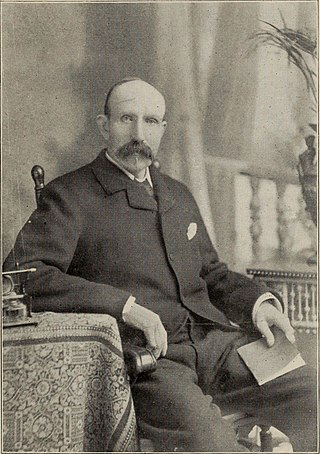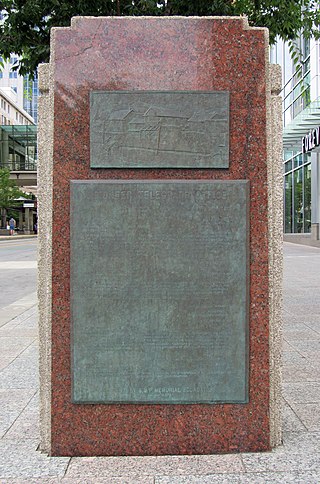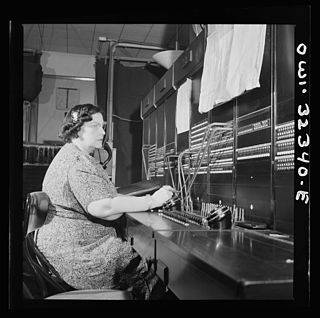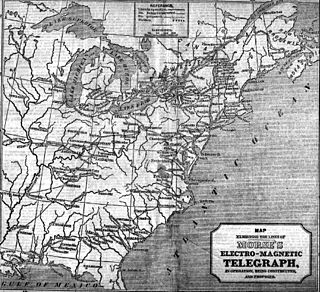Related Research Articles

Electrical telegraphs were point-to-point text messaging systems, primarily used from the 1840s until the late 20th century. It was the first electrical telecommunications system and the most widely used of a number of early messaging systems called telegraphs, that were devised to communicate text messages quicker than physical transportation. Electrical telegraphy can be considered to be the first example of electrical engineering.

Alfred Lewis Vail was an American machinist and inventor. Along with Samuel Morse, Vail was central in developing and commercializing American telegraphy between 1837 and 1844.

The Electric Telegraph Company (ETC) was a British telegraph company founded in 1846 by William Fothergill Cooke and John Ricardo. It was the world's first public telegraph company. The equipment used was the Cooke and Wheatstone telegraph, an electrical telegraph developed a few years earlier in collaboration with Charles Wheatstone. The system had been taken up by several railway companies for signalling purposes, but in forming the company Cooke intended to open up the technology to the public at large.

Jeptha Homer Wade was an American industrialist, philanthropist, and one of the founding members of Western Union Telegraph. Wade was born in Romulus, New York, the youngest of nine children of Jeptha and Sarah (Allen) Wade. He made the first Daguerreotypes west of New York, was a portrait painter, and moved to Adrian, Michigan, in 1840 before developing an interest in the telegraph.

Sir Robert Gillespie Reid was a Scottish railway contractor most famous for building large railway bridges in Canada and the United States. Founder of Reid Newfoundland Company, from 1889 until his death, he built, owned, and operated the Newfoundland Railway.

The Pacific Telegraph Company was one of the organizations responsible for constructing the telegraph line which resulted in the first transcontinental telegraph network in the United States. The company built the section of line between Julesburg, Colorado Territory and Salt Lake City, Utah Territory.

The first transcontinental telegraph was a line that connected the existing telegraph network in the eastern United States to a small network in California, by means of a link between Omaha, Nebraska and Carson City, Nevada, via Salt Lake City. It was a milestone in electrical engineering and in the formation of the United States of America. It served as the only method of near-instantaneous communication between the east and west coasts during the 1860s. For comparison, in 1841, the news of the death of President William Henry Harrison had taken 110 days to reach Los Angeles.

The Overland Telegraph Company was one of the organizations responsible for constructing the telegraph line which resulted in the first transcontinental telegraph network in the United States. The company built the section of line between Fort Churchill, Nevada Territory and Salt Lake City, Utah Territory.
James Reid may refer to:

Francis Ormand Jonathan Smith was a U.S. lawyer, legislator, and telegraph pioneer and financier.

Thomas Thompson Eckert was an officer in the U.S. Army, Chief of the War Department Telegraph Staff from 1862 to 1866, United States Assistant Secretary of War from 1866 to 1867 and an executive at Western Union.

Australia was a relatively early adopter of electrical telegraph technology in the middle of the nineteenth century, despite its low population densities and the difficult conditions sometimes encountered in laying lines. From 1858 onwards, the major capitals were progressively linked, culminating in the addition of Perth in 1877. Australia was linked to the rest of the world for the first time in 1872, through the Overland Telegraph which ran some 3,200 kilometres (2,000 mi) from Adelaide through to Darwin. The network continued to expand in size and sophistication until 1959 and in heavy usage until 1945, after which time telephone usage began to erode public patronage of telegraphy services. The final publicly provided telegraphy service was closed in 1993.

The Sholes and Glidden typewriter was the first commercially successful typewriter. Principally designed by the American inventor Christopher Latham Sholes, it was developed with the assistance of fellow printer Samuel W. Soule and amateur mechanic Carlos S. Glidden. Work began in 1867, but Soule left the enterprise shortly thereafter, replaced by James Densmore, who provided financial backing and the driving force behind the machine's continued development. After several short-lived attempts to manufacture the device, the machine was acquired by E. Remington and Sons in early 1873. An arms manufacturer seeking to diversify, Remington further refined the typewriter before finally placing it on the market on July 1, 1874.
Henry O'Reilly was an Irish-American businessman and telegraphy pioneer.

Women in telegraphy have been evident since the 1840s. The introduction of practical systems of telegraphy in the 1840s led to the creation of a new occupational category, the telegrapher, telegraphist or telegraph operator. Duties of the telegrapher included sending and receiving telegraphic messages, known as telegrams, using a variety of signaling systems, and routing of trains for the railroads. While telegraphy is often viewed as a males-only occupation, women were also employed as telegraph operators from its earliest days. Telegraphy was one of the first communications technology occupations open to women.

The Baltimore–Washington telegraph line was the first long-distance telegraph system set up to run overland in the United States.

The timeline of North American telegraphy is a chronology of notable events in the history of the electric telegraphy in the United States and Canada, including the rapid spread of telegraphic communications starting from 1844 and completion of the first transcontinental telegraph line in 1861.

The Montreal Telegraph Company was the first significant telegraph company in Canada.

Lion Forge Comics was an American comic book publisher founded in 2011 by David Steward II and Carl Reed, with headquarters formerly located in St. Louis, Missouri. The company had a strong focus on culturally diverse creators and stories. In 2019, it became an imprint label following the company's merger with Oni Press. The merged company, Oni–Lion Forge Publishing Group, is owned by Polarity. As of 2022, the Lion Forge name is now "largely dormant with Oni Press taking over the publishing side of things".

The British and Irish Magnetic Telegraph Company was founded by John Brett in 1850. The Magnetic was the principal competitor to the largest telegraph company in the United Kingdom, the Electric Telegraph Company. The Magnetic was the leading company in Ireland, while the Electric was the leading company in mainland Britain. Between them, they dominated the market until the telegraph was nationalised in 1870.